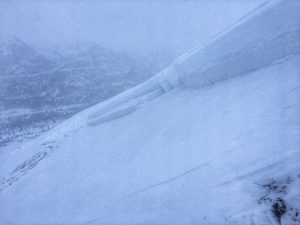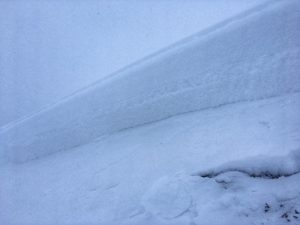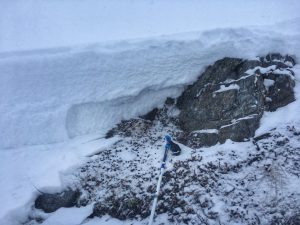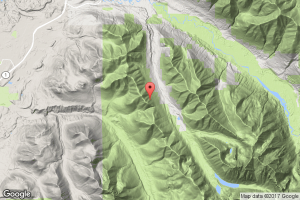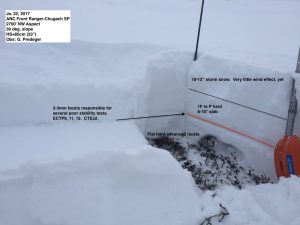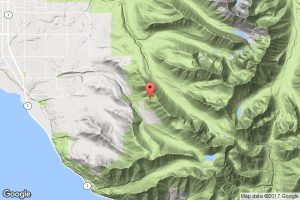Observations
Front Range – Middle Fork Campbell Creek:
Nordic ski from Basher trailhead to ~2200′ up the Middle Fork Campbell Creek. Tried to get back to Williwaw Lakes, but shutdown by moose. Be considerate, and don’t stress wildlife. You’re visiting their home, and they’re just trying to survive winter. Additionally, off-trail movement is SLOW (due to the deep snow) and a moose could trample you easily if it feels like it.
Generally 2-3′ snowpack (increasing with elevation to ~2200′). 10″+ new snow with very little to no wind affect in the mid elevations (below 2500′). While wind has yet to affect sub-alpine snow, the snow has definitely consolidated into a slab in the mid elevations as evidenced by shooting cracks and collapses (whumphs) with the snow breaking into large and consolidated chunks when trail breaking.
While dangerous avalanche conditions are expected to persist in the alpine this week, you can stay safe and enjoy the best nordic skiing we’ve had in half a decade!
Eagle River – South Fork – Hunter Pass area:
Skier triggered avalanche north of Hunter Pass on the lower East facing slopes of The Nipple.
This path is a repeat offender: a few skiers were caught and carried in this path last March. Click here for that observation and here for the associated avalanche investigation.
The below observation is sourced from the Chugach National Forest Avalanche Information Center’s observations page. It has been edited by the Anchorage Avalanche Center for clarity.
Group of 5 skiers followed pre-existing track up the right side of the high traffic “gully” just South of South Fork Creek Trailhead until ~3200ft and begin traversing North searching for deeper, more consistent snow pack (*AAC note: they are likely referring to the typical North Bowl approach up the Hunter Pass summer trail). Snow pack was variable, light, soft snow. Thickness varied from inches to feet. Lightly snowing, low visibility. No wind.
Avalanche details:
| Trigger | Skier | Avalanche Type | Soft Slab | Aspect | East |
|---|---|---|---|---|---|
| Elevation | 3000ft | Slope Angle | 35deg | Crown Depth | 2ft |
| Width | 100ft | Length | 300ft |
Second skier in group skied near a buried rock (initiation spot shown in photo), which caused the slabs to release down to the ground. Two distinct slabs could be seen post-avalanche. Soft upper layer slab and a harder lower slab. Area appeared wind loaded. Average depth 2.5ft, maximum estimated around 3ft. Avalanche propagated away from the skier to the next weak points (rocks). Skier was carried less than 20ft and stopped upon digging skis into exposed ground. First skier was looker’s right of the avalanche out of harm’s way on a slight hill.
Obvious signs of instability:
| Recent Avalanches? | No | Collapsing (Whumphing)? | Yes | Cracking (Shooting cracks)? | Yes |
|---|
Whumping was experienced on the ski out in the lower elevations. Not experienced on the way up due to using pre-existing skin track. Shooting cracks seen immediately preceding the avalanche and only in that wind loaded area. None seen during quick tests next to skin track on way up.
Weather:
Light snow, low visibility, no wind.
View of deepest section of crown:
Looking from initiation point, shows two slab layers:
About halfway down looking back up at the crown:
Location:
Front Range – Peak 3:
The below observation is sourced from the Chugach National Forest Avalanche Information Center’s observations page. It has been edited by the Anchorage Avalanche Center for clarity.
Red Flags (obvious signs of instability):
Small, localized collapses (whumphing) from parking lot to about 2600′. A couple larger collapses (whumphs) at 2700′.
Weather:
12-15 degrees F. Snowing ~1cm/ hr most of the day. Snow tapered off around 5PM to clearing skies. Winds were nonexistent at mid elevations (below 2500′).
Surface Conditions:
10-12″ low density powder. Not going take much wind to transport this weekend’s snow and build wind slabs.
Snowpack:

